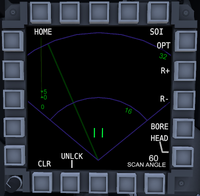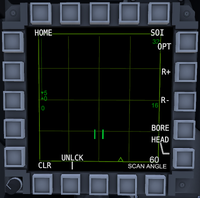Draft:Radar (Mechanic)
Radar is one of several target detection, acquisition, and tracking methods in VTOL VR. It works by sending out pulses and registering the 'echos' they send back to the radar source upon bouncing off of another object. In the context of VTOL VR, most radars are primarily intended for acquiring air targets such as aircraft and missiles.
Two main factors play into radar detection of units in VTOL VR: the radar source's power and the detectable object's Radar Cross-Section (RCS). Every radar source in VTOL VR will have a certain distance at which transmitted radio waves have little to no chance of providing any meaningful returns for the search radar. An object's RCS determines how much of a radar's radio waves are reflected back to the radar source, and is mainly dependent on the relative surface area that the radar in question can see. An object is considered 'detected' by a radar source if two criteria are fulfilled:
- The object is hit by the propagating radio waves.
- Enough of the radio waves reflect off the object and back to the searching radar to be registered by the radar system.
For example, a fighter jet flying with its dorsal or ventral aspect facing directly towards a radar will give off a significantly higher RCS than if only its front is facing the radar, making it more visible to the radar from longer ranges.
In general, an aircraft with more flat edges across its frame, such as the F/A-26B, will be much more visible to a radar than other aircraft due to its geometry causing more radio waves to reflect back to the radar source. Conversely, aircraft like the F-45A will reflect fewer radio waves back to a radar source due to its more curved design; as such, it will be harder for radars to detect and track an F-45A from range than something like an F/A-26B.
Display Modes
There are two available display modes for the radar. Those being the standard PPI-Scope and the B-Scope. Both, are identical in function yet different in operation.
Demonstration of B-Scope use and unique features in radar FWD mode.
Demonstration of B-Scope use and unique features (and struggles) in radar SLEW mode.
Advanced
Radar Cross-Section
Externally mounted armaments increase the aircraft's RCS in all directions, but affect stealthy aspects more than others. The RCS increase varies by weapon and rail type. As a rule of thumb, weapons which are bigger and/or have larger fins will increase RCS by a larger amount. Most missiles/bombs individually increase RCS by values between 2.5 to 5.5.[Confirmation needed]
Detection
The detection range of a radar is meters. You can also calculate it by taking the RCS 1 range and multiplying it by
| Name | RWR Symbol | RCS 1 range | TX Power | RX Strength |
|---|---|---|---|---|
| Early Warning | AD / EW | 22.59 nm | 500,000 | 3,500 |
| AWACS | E4 / AE | 18.70 nm | 300,000 | 4,000 |
| Missile Warning | WR / MW | 14.79 nm | 15,000 | 50,000 |
| EF-24G | 24 / EF | 4.95 nm | 140,000 | 600 |
| MAD-4 | 4 | 4.83 nm | 160,000 | 500 |
| F-45A* | 45 / FS | 4.68 nm | 125,000 | 600 |
| NMSS Long Range | LR | 4.68 nm | 150,000 | 500 |
| F/A-26B | 26 / FA | 4.27 nm | 125,000 | 500 |
| ASF-58 | F+ | 4.09 nm | 115,000 | 500 |
| SAM S/A | E / DS | 4.09 nm | 115,000 | 500 |
| ASF-30 / ASF-33 | F | 3.91 nm | 105,000 | 500 |
| T-55 | 55 / T | 3.87 nm | 82,000 | 625 |
| SL-MRM / Watchman | SL | 3.72 nm | 95,000 | 500 |
| Cruiser | DM | 3.38 nm | 112,000 | 350 |
| NMSS Vertical | MC | 3.05 nm | 80,000 | 400 |
| REDFOR FireCtrl | SR | 3.05 nm | 80,000 | 400 |
| BLUFOR FireCtrl | R | 2.86 nm | 80,000 | 350 |
* this data is for players, The AI F45's radar is equivalent to an F/A-26B


